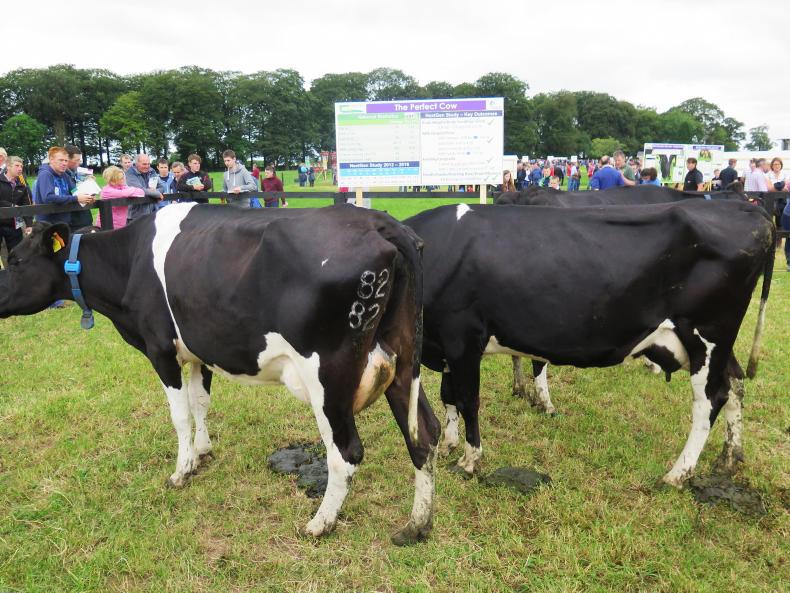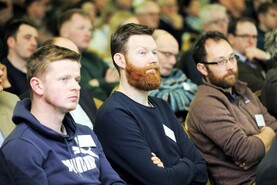There was an exceptional turnout at the Moorepark open day this year with most people in good form, milk price in a good place and most farms having a good production year so far.
The first wave of dairy expansion has taken place across the country and after the milk price recovery this year, it was a good time to take stock of where we are and maybe re-focus for the next few years.
The Moorepark farm looked exceptional for the day. There were some excellent demonstrations on grass measuring and pre- and post-grazing covers. The reseeding demonstration gave a very clear message to the attendants about treatment of swards pre- and post-sowing – Round-up first and a good post-emergence spray four to five weeks after sowing.
The cow breeding message was again very well communicated that crossbreeding with Jersey sires will give €100 to €150 extra profit per cow, per lactation for the lifetime of the cow.
This message was reinforced on a few stands around the farm, with the extra profit coming from extra kilo of milk solids produced per cow, better fertility and the more intangible X-factor of an easycare cow that is easy to look after in large herds.
This was the message that generated the most discussion on the day and greeted, as usual, with scepticism from corners of the crowd.
The researchers are convinced that this is the way to go and the advice was to jump in with both feet and to use a pure Jersey bull on all the black and white cows out there.
Using a crossbred bull would not give enough hybrid vigour on that first cross and would be a lost opportunity. This type of cow has performed very well in Moorepark in numerous trials, with the only caveat being the average enough performance from the Holstein Friesian cohorts in those trials.
Farmers are still voting with their feet on Jersey bulls, however. As it stands, these bulls are only siring about 5% or 6% of the national herd annually. It will be interesting to see if this will change over the next few years after the big push at this event.
The elephant in the room in the shape of bull calves was once again ignored throughout the event though. We were told that the financial cost of producing worthless calves would be gained back quickly when the heifer calves reached maturity four or five years down the road. You have to be prepared to take the financial hit for the intervening years.
The cost to our clean green image could be a lot higher and longer lasting without some planning. We are targeting the milk that these cows produce at a mature urban market throughout Europe and the UK.
We have a very positive image in these countries and our products often command a premium in these markets. We are always just a short click or push notification away from a negative image of our cast off worthless calves appearing in the living rooms of this market.
The next time we are told that we should crossbreed with pure Jersey bulls, we also need to see the plan that the industry has in place for these calves. We need to be upfront with our plans for these animals and not hide behind the trials and placards extolling the virtues of the cows.
Some 15% use of pure Jersey semen would result in 100,000 worthless bull calves born in the space of six weeks the following spring.
Is there a plan in place for these calves?
Read more
Moorepark 2017: hit the right targets for 10 times more income
Editorial: We need to go back to basics if we are to drive dairy profitability
Village life at Moorepark 2017
Full coverage: Moorepark 2017
There was an exceptional turnout at the Moorepark open day this year with most people in good form, milk price in a good place and most farms having a good production year so far.
The first wave of dairy expansion has taken place across the country and after the milk price recovery this year, it was a good time to take stock of where we are and maybe re-focus for the next few years.
The Moorepark farm looked exceptional for the day. There were some excellent demonstrations on grass measuring and pre- and post-grazing covers. The reseeding demonstration gave a very clear message to the attendants about treatment of swards pre- and post-sowing – Round-up first and a good post-emergence spray four to five weeks after sowing.
The cow breeding message was again very well communicated that crossbreeding with Jersey sires will give €100 to €150 extra profit per cow, per lactation for the lifetime of the cow.
This message was reinforced on a few stands around the farm, with the extra profit coming from extra kilo of milk solids produced per cow, better fertility and the more intangible X-factor of an easycare cow that is easy to look after in large herds.
This was the message that generated the most discussion on the day and greeted, as usual, with scepticism from corners of the crowd.
The researchers are convinced that this is the way to go and the advice was to jump in with both feet and to use a pure Jersey bull on all the black and white cows out there.
Using a crossbred bull would not give enough hybrid vigour on that first cross and would be a lost opportunity. This type of cow has performed very well in Moorepark in numerous trials, with the only caveat being the average enough performance from the Holstein Friesian cohorts in those trials.
Farmers are still voting with their feet on Jersey bulls, however. As it stands, these bulls are only siring about 5% or 6% of the national herd annually. It will be interesting to see if this will change over the next few years after the big push at this event.
The elephant in the room in the shape of bull calves was once again ignored throughout the event though. We were told that the financial cost of producing worthless calves would be gained back quickly when the heifer calves reached maturity four or five years down the road. You have to be prepared to take the financial hit for the intervening years.
The cost to our clean green image could be a lot higher and longer lasting without some planning. We are targeting the milk that these cows produce at a mature urban market throughout Europe and the UK.
We have a very positive image in these countries and our products often command a premium in these markets. We are always just a short click or push notification away from a negative image of our cast off worthless calves appearing in the living rooms of this market.
The next time we are told that we should crossbreed with pure Jersey bulls, we also need to see the plan that the industry has in place for these calves. We need to be upfront with our plans for these animals and not hide behind the trials and placards extolling the virtues of the cows.
Some 15% use of pure Jersey semen would result in 100,000 worthless bull calves born in the space of six weeks the following spring.
Is there a plan in place for these calves?
Read more
Moorepark 2017: hit the right targets for 10 times more income
Editorial: We need to go back to basics if we are to drive dairy profitability
Village life at Moorepark 2017
Full coverage: Moorepark 2017






 This is a subscriber-only article
This is a subscriber-only article










SHARING OPTIONS: